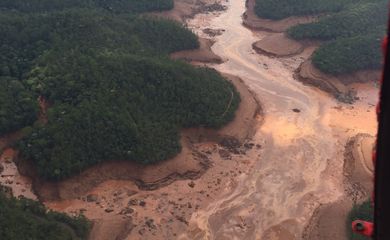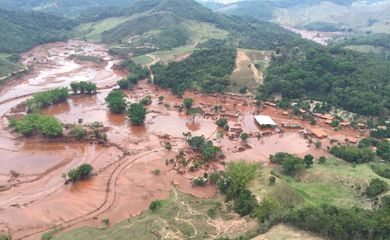Collapsed dam released 62 million cubic meters of tailings


Minas Gerais Governor Fernando Pimentel and Minister for National Integration Gilberto Occhi visited the area affected by the dams failure in the town of Mariana, Minas Gerais.

Samarco's directors, the mining company responsible for the dams that collapsed in Minas Gerais, reported Friday (Nov. 6) that about 62 million cubic meters of tailings were released into the environment, an amount enough to fill 24,800 Olympic-size swimming pools.
The Fundão dam was the first to burst, at around 15h on Thursday (Nov. 5). Works were being carried out at the dam's structure and for that reason the dam was holding 55 million cubic meters back, while its full capacity would be 60 million. According to Samarco, the works had not caused the failure. The Santarém dam had reached its limit of capacity of 7 million cubic meters.
Samarco's CEO Ricardo Vescovi declared the waste material does not contain chemicals and should not lead to further consequences, in addition to the physical destruction caused by the mud wall from Thursday (Nov. 5) in Bento Rodrigues village. The mud, he reported, is mainly composed of silica and water.
André Naime, specialist in risk analysis and environmental analyst at the Brazilian Institute of Environment and Renewable Natural Resources (IBAMA) from Minas Gerais, said it was too early to examine the environmental impact the disaster has caused in the area, because so far there is no precise information about the chemical composition of the waste. "Iron-ore wastes usually show low pollution potential and silica is inert and not harmful to human health."
According to Naime, uncontrolled discharges of substances such as happened can affect the quality of the environment. "The mud flows engulfed vegetation, watershed areas and caused sediment transport and siltation of water bodies, in addition to losses inflicted on the populations, with impacts that were evident even from the pictures," he declared.
Regarding possible impacts on the region's groundwater, from which water is taken to supply the population, the specialist said that the silica alone would not be a threat. "But if the waste is also carrying any soluble or dissolved contaminant, the groundwater could also be affected."
The risk-factor classification of the two tailings dams at the State Environmental Foundation (FEAM)—responsible for licensing the dams—is Class 3, which means they have "high potential environmental risks". The classification is based on the dam height, tailings volume, the environmental interest in the downstream areas of the dam, and human occupancy, among other parameters.
According to FEAM's press office, efforts are intensified on the victims' care, but the next step is to evaluate the environmental impact. "The consequences for the environment will be identified as soon as the Civil Defense authorizes further analysis at the place."
The foundation also reported that they have been collecting samples of water and sediments from water bodies near the disaster. According to FEAM, the cost for environmental remediation shall be cover by Samarco.
Translated by Amarílis Anchieta
Fonte: Collapsed dam released 62 million cubic meters of tailings



